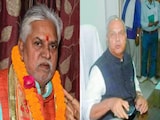The National Democratic Alliance (NDA) is on course to secure one of its strongest mandates in two decades as the counting of votes cast in the Bihar Assembly elections continues. With the coalition crossing 200 seats in the 243-member Assembly, the result marks a consolidation of support for Chief Minister Nitish Kumar and the BJP-led alliance, eclipsing its own 2010 performance.
Here is a look at the key figures, parties and voter groups that shaped the 2025 Bihar election -- and those who emerged diminished from it.
WINNERS
1. Nitish Kumar
After 20 years in office, Chief Minister Nitish Kumar's Janata Dal (United) not only countered anti-incumbency but registered a clear gain, leading in more than 80 seats. The NDA's combined tally above 200 seats ensures Kumar a fifth term as Chief Minister.
The outcome halts Tejashwi Yadav's efforts to position himself as Bihar's next leader. The "youth versus experience" contrast that dominated the opposition's pitch did not translate into votes.
2. Chirag Paswan
Chirag Paswan has staged one of the most notable comebacks of this election. After winning only one seat in 2020 but securing nearly 6 per cent of the vote, his Lok Janshakti Party (Ram Vilas) translated support into 22 of the 29 seats it contested.
The consolidation of the Paswan vote and Chirag's appeal among young voters and Dalit communities played a key role.
3. Asaduddin Owaisi and AIMIM
The Asaduddin Owaisi-led All India Majlis-e-Ittehadul Muslimeen (AIMIM) registered a strong performance in the Seemanchal region of Bihar.
Election Commission of India (ECI) data showed AIMIM winning four seats -- Jokihat (Araria), Kochadhaman (Kishanganj), Amour (Purnea) and Baisi (Purnea). Incidentally, Jokihat, Kochadhaman, Amour, and Baisi were also secured by the party in the 2020 Assembly elections.
4. Women Voters
Women voters were instrumental in shaping the 2025 mandate. For the first time in Bihar's electoral history, women voted at a rate far higher than men. Their turnout moved the needle decisively toward the NDA.
Their turnout exceeded that of men by nearly nine percentage points -- 71.6 per cent versus 62.8 per cent. Welfare schemes targeting women, including the Rs 10,000 Mukhyamantri Mahila Rozgar Yojana, helped consolidate support among poorer and backward communities.
5. The National Democratic Alliance (NDA)
The NDA's Smaller partners -- Jitan Ram Manjhi's Hindustani Awam Morcha (HAM, Upendra Kushwaha's Rashtriya Lok Morcha and Chirag Paswan's LJP(RV) -- delivered strongly in the polls.
HAM led in five out of six seats, LJP(RV) in 20, and RLM in four.
LOSERS
1. Tejashwi Yadav and Rashtriya Janata Dal (RJD)
Tejashwi Yadav, projected as the Opposition's chief ministerial face, was unable to translate any anti-incumbency against Nitish Kumar into votes; however, he won his Raghopur stronghold.
This is the RJD's second-worst performance in its electoral history, after the 2010 tally of 22 seats. As of 6:30 pm, the party was leading in just 19 seats.
The 2020 election had elevated Tejashwi as an emerging leader in Bihar. The 2025 verdict halts that momentum.
2. Rahul Gandhi
The Congress again failed to make gains in Bihar, ending with a single-digit seat count. This continues a trend from 2020, when Congress contested 70 seats but won only 19 and weakened the Mahagathbandhan's prospects.
Despite Rahul Gandhi's "Voter Adhikar Yatra," allegations of "vote chori," and campaigns against the Special Intensive Revision (SIR) exercise, the party struggled to connect with the electorate.
3. Prashant Kishor
Prashant Kishor -- long known as India's most influential political strategist -- finds himself among the election's biggest losers. After a two-year padyatra and significant visibility, Jan Suraaj failed to make any impact and polled fewer votes than NOTA.
Kishor's development-first pitch could not gain traction. His decision not to contest seats eventually created further confusion about the party's direction.
4. Mukesh Sahani
Projected as a key challenger in the Seemanchal region, Mukesh Sahani could not perform despite being named deputy chief ministerial face by the Mahagathbandhan, that too after much hard bargaining.
His Vikassheel Insaan Party (VIP) failed to convert caste-based mobilisation into seats. The Nishad vote, which he sought to consolidate, drifted toward the NDA, attracted by welfare guarantees.
5. INDIA Bloc
The INDIA bloc has suffered a significant setback ahead of a string of key elections, including in Bengal and Tamil Nadu. Seat-sharing disagreements, disjointed messaging and unclear leadership contributed to a weak performance.
Election Commission data showed the NDA leading in 204 seats by late afternoon on counting day, with the BJP ahead in 92, JD(U) in 83, LJP(RV) in 20, HAM in five and RLM in four. The Opposition secured leads in only 32 seats.
Congress collapsed to single digits, RJD failed to expand its base, and Left parties could not retain their earlier pockets of influence.















